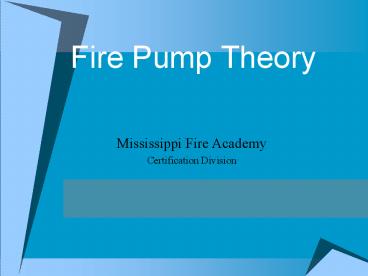Fire Pump Theory - PowerPoint PPT Presentation
1 / 41
Title:
Fire Pump Theory
Description:
Produce effective hand or master streams, given the sources specified in the ... Tachometer. Records engine speed in revolutions per minute ... – PowerPoint PPT presentation
Number of Views:2098
Avg rating:4.5/5.0
Title: Fire Pump Theory
1
Fire Pump Theory
- Mississippi Fire Academy
- Certification Division
2
Objectives
- 3-2.1, 6-2.1
- Produce effective hand or master streams, given
the sources specified in the following list, so
that the pump is safely engages, all pressure
control and vehicle safety devices are set, the
rated flow of the nozzles is achieved, and
maintained, and the apparatus is continuously for
potential problems. - Internal Tank
- Pressurized source
- Static source
- Transfer from internal tank to external source
3
Positive Displacement Pumps
- Hydraulic Law When pressure is applied to a
confined liquid, the same pressure is equally
transmitted within a liquid in all directions
4
2 Basic Types
- Pistons Rotary
- Pistons
- Pistons moves back forth in cylinder
- Rotary- 2 types
- Rotary gear
- Rotary vane
5
Centrifugal Pumps
- Depends on velocity of water produced by
centrifugal force to provide necessary pump
discharge pressure
6
Principle of Operation Construction
- Disk tends to throw water
- Velocity is created is converted into more
pressure - Volume is dependent
7
Terms to be familiar with
- Impeller- transmit energy to pressure
- Volute- water passes and pressure is increased
8
3 Factors That Influence Pressure
- Amount of Water
- Speed the impeller is turning
- Pressure the water enters
9
Single-Stage Centrifugal Pump
- Constructed of one impeller
10
Two-Stage Centrifugal Fire Pumps
- Two Impellers within a single housing
- Allow delivery in Volume(parallel) or Pressure
(series)
11
Pump Wear Rings Packing
- Higher rpm, the more wear
- Indication of wear
- Increased rpm to pump capacity
- To restore capacity
- Replace wear rings
- Replace hub of impeller
- When discharges are shutoff, heat builds
- Always circulate water
12
Pump Mounting and Drive Arrangements
- Cost, appearance, space requirements, and ease of
maintenance are considerations
13
Auxiliary Engine-Driven Pumps
- Independent engine fire pumps
14
Power Take-Off Drive
- Mostly used on wildland, and mobile water supply
apparatus.
15
Front-Mounted Pumps
- More susceptible to freezing temperatures
- Vulnerable to collisions
- Pump control are in front of the vehicle
16
Midship Transfer Drive
- Located in the drive line between the
transmission rear axle
17
Rear Mount Pumps
- More weight distribution
- Gives more compartment space
- Driver is exposed to oncoming traffic
18
Pump Piping and Valves
- Corrosion resistant, and made of cast iron,
brass, stainless steel, or galvanized steel
19
Intake Piping
- Tank Water
- Most fires can be extinguished
- 500 gpm or less should flow 250 gpm
- Greater than 500 gpm, flow at least 500 gpm
- External Water
- Primary piping is large diameter
- Round near the intake
20
Discharge Piping
- 750 gpm or greater should be equipped with at
least 2 2½ discharges - Smaller outlets used for preconnects
- Tank fill lines should be provided
21
Valves
- Should permit flow with minimum friction loss
22
Pump Drains
- Relieves pressure
- Drain lines used to drain water during freezing
23
Automatic Pressure Control Devices
- NFPA requires devices to operate within 3-10
seconds with no more than 30 psi rise
24
Relief Valves
- Discharge relief valves
- Spring controlled pilot valves
- Alternative relief valves
- Intake relief valves
- Factory supplied
- Add-on device
25
Pressure Governor
- Regulates by mechanical or electronic means
26
Priming Methods and Devices
- Success depends on ability to create a lower
pressure
27
Positive Displacement Pumps
- High rpm required
- 1,000-1,200 rpm
- Most require oil
- Seals gaps
- Preserve and prevent corrosion
28
Exhaust Primers
- Uses venturi principle
- Requires maintenance due to carbon deposits
29
Vacuum Primers
- Simplest type
- Line connected from intake manifold to intake of
fire pump - 2 dangerous conditions
- Explosives gases
- Water drawn into manifold
30
Pump Panel Instrumentation
31
Master Intake and Discharge Gauges
- Master Intake Gauge
- Measures positive negative
- Calibrated 0-600 psi positive, 0-30 inches
negative - Provides information of water available vacuum
- Master Pump Discharge Gauge
- Registers pressure leaving the pump
32
Tachometer
- Records engine speed in revolutions per minute
33
Pump Engine Coolant Temperature Indicator
- Reflects temperature of engine coolant
34
Pump Engine Oil Pressure Indicator
- Shows adequacy oil pressure
35
Pump Overheat Indicator
- Visual or audible indicator
36
Voltmeter
- Indicates condition of battery and alternator
output by measuring voltage.
37
Pump Pressure Indicators (Discharge Gauges)
- Connected to individual discharges
38
Pumping Engine Throttle
- Used to increase or decrease engine speed during
pumping operations
39
Primer Control
- Controls priming device for drafting
40
Water Tank Level Indicator
- Indicate the amount of water level in tank
41
Auxiliary Cooling Devices
- 2 types of auxiliary coolers
- Marine
- Immersion































